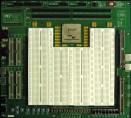 Labkit Documentation
Labkit Documentation6.111 home → Labkit home
 Labkit Documentation
Labkit DocumentationBased on a 6-million gate platform-scale FPGA, the FPGA labkit is designed to facilitate complex and high-performance projects. It features built-in audio and video codecs, and a host of other features.
The documentation here is intentionally somewhat skeletal. Students are encouraged (and expected) to refer to the manufacturers' user manuals, datasheets, and application notes, in order to understand all the details of the labkit hardware, and the software used to develop programs for it. That said, we do not want students to waste a lot of time feeling overwhelmed, and uncertain how to get started. The documentation on this web site is intended to provide enough of an overview of the hardware and software systems so that students will be able to immediately dive into the manufacturer's original documentation, and understand what is going on.
Students just getting started with the FPGA labkit should read through the "Getting Started" software tutorial, which will walk you through the implementation of a very simple design in the ISE software. The programming methods tutorial will explain how to download designs compiled in ISE to the labkit. Also, read the hardware basics tutorial, for an overview of the basic switches, LEDs, and connectors on the labkit, and how to use them.
While working on their projects, students will undoubtedly frequently want to refer to the the labkit schematic, as well as the template top-level Verilog module labkit.v and the standard constraints file labkit.ucf.
Getting Started with ISEAn Introduction to the Xilinx ISE software used to program the labkit's FPGA. |
Programming the LabkitInstructions for programming designs compiled with ISE onto the actual labkit hardware. |
Simulating with ModelSimHow to setup and behavioral and gate-level simulations. |
Debugging with ChipScopeObserve internal FPGA signals using a simple logic analyzer implemented in the FPGA. |
The basicsBreadboards, clocks, LEDs, switches, generic i/o signals, and logic analyzer connectors. |
AudioAn AC'97 codec allows for stereo audio input and output. |
VGA VideoA dedicated video DAC drives any VGA-compatible monitor. |
TV VideoBuilt in video encoder and decoder chips handle composite and s-video input and output. |
|
SRAMs4MB of high-speed synchronous ZBT memory is soldered onto the labkit PCB. |
Radio KitsA limited number of Chipcon CC1010 and CC2420 radio kits are available. |
DatasheetsManufacturers' datasheets for all the major labkit ICs. |
TestsPrecompiled test programs for the labkit. Make sure your labkit is in working order. |